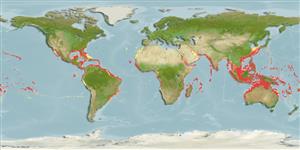Common names from other countries
>
Eupercaria/misc (Various families in series Eupercaria) >
Priacanthidae (Bigeyes or catalufas)
Etymology: Heteropriacanthus: Greek, heteros = other + Greek, prion = saw + greek, akantha = thorn (Ref. 45335).
More on author: Lacepède.
Environment: milieu / climate zone / depth range / distribution range
นิเวศวิทยา
เกี่ยวกับทะเล,น้ำเค็ม เกี่ยวกับหินโสโครก; ระดับความลึก 3 - 300 m (Ref. 27000), usually 3 - 35 m (Ref. 40849). Subtropical; 33°N - 32°S, 180°W - 180°E
Atlantic and SW Indian Ocean: restricted. Former circumglobal distribution now accounted to former synonyms H. carolinus (widespread in the Indo-Pacific region) and H. fulgens (northeastern Atlantic Ocean).
ขนาด / น้ำหนัก / Age
Maturity: Lm ? range ? - ? cm
Max length : 50.7 cm TL เพศผู้/กระเทย; (Ref. 9990); common length : 20.0 cm SL เพศผู้/กระเทย; (Ref. 55763); น้ำหนักสูงสุดที่มีการรายงาน: 2.7 kg (Ref. 9990)
เงี่ยงครีบหลัง (รวม) : 10; ก้านครีบอ่อนที่หาง (รวม) : 12 - 13; เงี่ยงครีบก้น: 3; ก้านครีบอ่อนที่ก้น: 13 - 14. Silvery pink, mottled red or solid red in color; median fins with faint dark dots. Pelvic fins dusky or pale and without distinct spots (Ref. 4328). Section of preopercle behind canal striated and without scales (Ref. 26938).
Common in lagoon and seaward reefs, primarily around islands. Under or near ledges by day (Ref. 9710). Benthopelagic (Ref. 58302). Juvenile pelagic (Ref. 9335). Nocturnal (Ref. 5213), feeding mainly on octopi, pelagic shrimp, stomatopods, crabs, small fish, and polychaetes. Solitary (Ref. 5213). During the day usually occurs singly or in small groups but at dusk it may gather in large numbers (Ref. 37816). Known to produce sound. Marketed fresh (Ref. 3800). Minimum depth reported taken from Ref. 30874.
Life cycle and mating behavior
Maturities | การสืบพันธุ์ | Spawnings | Egg(s) | Fecundities | ตัวอ่อน
Fernandez-Silva, I. and H.-C. Ho, 2017. Revision of the cicrumtropical glasseye fish Heteropriacanthus cruentatus (Perciformes: Priacanthidae), with resurrection of two species. Zootaxa 4273(3):341-361. (Ref. 115564)
IUCN Red List Status (Ref. 130435)
CITES (Ref. 128078)
Not Evaluated
Threat to humans
Reports of ciguatera poisoning (Ref. 30911)
Human uses
การประมง: มีการค้าเพียงเล็กน้อย; สถานที่แสดงสัตว์และพืชน้ำ: การค้า
เครื่องมือ
Special reports
Download XML
แหล่งที่มาจากอินเตอร์เน็ต
Estimates based on models
Preferred temperature (Ref.
115969): 23.3 - 29, mean 27.4 (based on 2452 cells).
Phylogenetic diversity index (Ref.
82804): PD
50 = 1.0000 [Uniqueness, from 0.5 = low to 2.0 = high].
Bayesian length-weight: a=0.01622 (0.01014 - 0.02593), b=2.88 (2.75 - 3.01), in cm Total Length, based on LWR estimates for this species & (Sub)family-body (Ref.
93245).
ระดับชั้นอาหาร (Ref.
69278): 3.6 ±0.2 se; based on diet studies.
ความสามารถในการกลับคืนสู่ปกติ (Ref.
120179): ขนาดกลาง, เวลาต่ำสุดที่จะทำให้ประชากรเพิ่มขึ้นเป็น 2 เท่าใช้เวลา 1.4 - 4.4 ปี (Preliminary K or Fecundity.).
Fishing Vulnerability (Ref.
59153): Moderate vulnerability (40 of 100).
